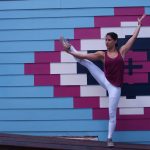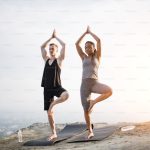Sequencing a normal length class is challenging enough, but what about if you only have a short amount of time? How can you ensure that your students still get a well-balanced practice? Let’s look into the different ways that you can make this work as a yoga teacher.
Getting the timing right in your yoga classes is a skill that takes time, practice and experience. Even extremely experienced yoga teachers can misjudge the length of the classes, as especially with larger numbers of students a fair amount of time can get taken up with class management. However, beginning and ending your classes on time is your responsibility and it’s up to you as a teacher to ensure that you leave enough time for savasana at the end of the class, or conversely, don’t end up with masses of time at the end, leaving the students wondering if they’re getting their money’s worth. This is especially important when you’re expected to provide a shorter, condensed yoga class.
Before planning any class, long or short, it’s worth bearing in mind the general principle of yoga sequencing: simple warms up, leading to more intensely challenging poses, then slowing down the pace with cooling poses and ending with a final relaxation.
Pick A Focus Pose
Instead of trying to cram the usual number of poses into a shorter amount of time, try editing the class down to focusing on a single pose, for example, Warrior III Pose (Virabhadrasana C).
Begin with a gentle warm up, focusing on lengthening the hamstrings, using poses such as Downward Dog and Intense Forward Bend Pose (Uttanasana), then stretching out the sides of the trunk, with poses such as Gate Pose (Parighasana). Move onto Reclining Hand to Foot Pose (Supta Padangustasana A) and get the students to take their arms over their heads, thus doing a supine, inverted version of Virabhadrasana C.
Once you reach the focus pose, try doing it a number of different ways in order to fully explore the pose, for example, with the hands to the wall or with the foot to the wall. Alternatively, repeat the same pose, focusing on a different aspect of the pose each time. With Warrior III it’s a little trickier as for many people simply staying up in the pose is enough to focus on, but they could try extending into the back heel, and the next time, focus on stretching into the fingertips.
See Also: Firm Foundations for Stronger Poses
Fast and Furious Class
If your class is young and fit why not take advantage of the shorter timeframe to get them to really work up a sweat. Because they won’t need to sustain their efforts for as long, you could work them even harder!
Begin the class with three Sun Salutations and then move straight onto the standing poses, such as Triangle Pose, Extended Side Angle Pose and Half Moon Pose. Then include some arm balances, Crow Pose (Bakasana) for example, and move onto inversions, starting with Handstand (Adho Mukha Vrksasana) to keep the energy levels up. After this, get their core working with some abdominal poses, such as Boat Pose (Paripurna Navasana). Begin to cool the class down with some standing forward bends, then make sure they have time to completely relax and regroup with Corpse Pose (Savasana).
To make sure your sequence will fit into the time, make sure you run it through on your own first, giving a bit of extra time to allow for the odd delay. Plus make sure you let your students know which type of Sun Salutation you’re going to take them through as there are quite a few variations out there.
Energy Boosting Class
If your class is in the morning, use your short yoga class as a way to wake up and invigorate your students, both physically and mentally. Incorporate standing poses and back bends as these are both energising and opening.
Warm up your students’ spines with Cat-Cow Pose, making sure you bring the spine back to the neutral position between curves. Progress to a vinyasa-style flow from one standing yoga pose to another, for example, moving from Intense Side Stretch Pose (Parsvottanasana) to Revolved Triangle Pose (Parivrtta Trikonasana) moving forwards into Revolved Half Moon Pose (Parivrtta Ardha Chandrasana). Once your students have heated up then move onto backbends such as Upward Facing Dog (Urdhva Mukha Svanasana) and Camel Pose (Ustrasana), culminating in Bow Pose (Dhanurasana). Cool down with gentle twists before Bridge Pose and relaxation.
See Also: 4 Steps to Safer Back Bends
Stress Buster
Sometimes, our bodies just need a bit of time out, especially in late classes at the end of a busy day. Why not use a shorter time frame to challenge your students minds rather than their bodies?
Your stress-busting class could involve a few restorative poses to quieten the students’ minds and bring them into their bodies, start with: Supine Bound Angle Pose (Supta Baddha Konasana) or Child Pose with the head supported (Adho Mukha Virasana). Then move onto some quiet forward bends, but with the head supported to encourage the mind to soften. Next spend five to ten minutes practising pranayama with the chest raised on blankets or a bolster and finally, make time for a ten minute Corpse Pose to end the class.
See Also: Pranayama Sequencing – Making Time for Pranayama
Top Tips for Building a Condensed Yoga Class:
- It will make your life easier if the poses you choose don’t require complicated props.
- Make sure you start your lesson on time in order to maximise the lesson.
- Think on your feet — if you’re running over, take out a couple of poses to ensure you have time for the essentials.
- Ensure the class flows by keeping digressions and interruptions to a minimum.
- Don’t be tempted to cut out inversions or skip savasana in order to fit in more poses.
Most of all, try to consider that less is more. Students will always be more grateful for a class where they can feel they’ve accomplished something, rather than rushing through a sequence to make it fit the time. Remember that there will always be poses you won’t be able to teach in a certain class, and that’s just more reason for your students to come back!












